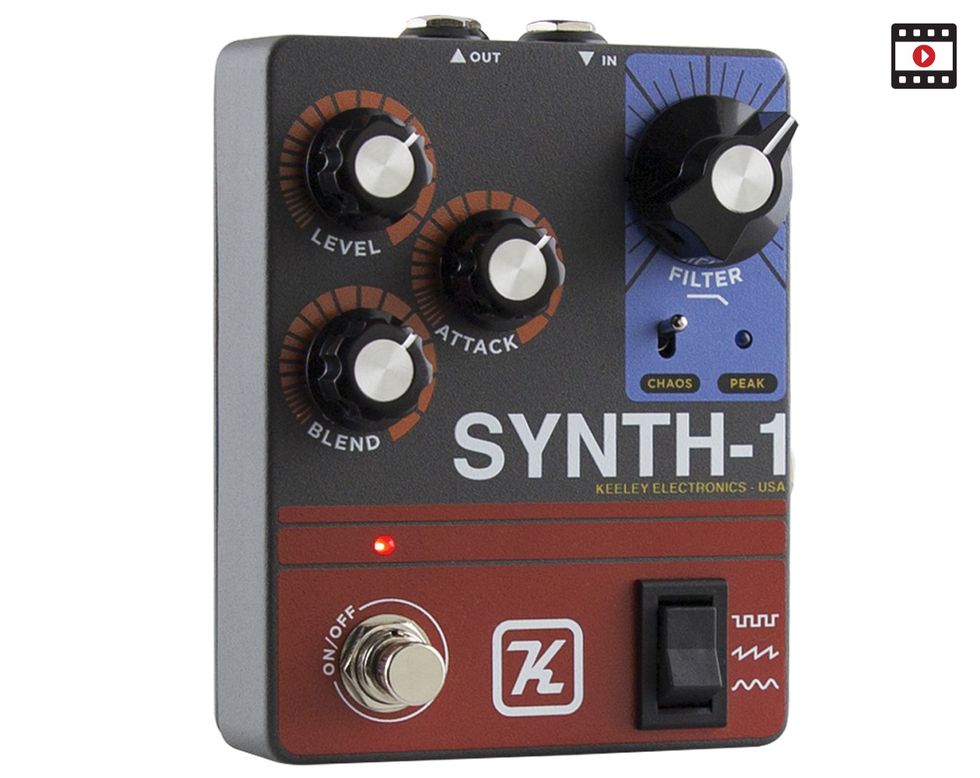RatingsPros:Speedy monophonic synth tracking. Good UI. Fine slow-attack sounds. Real-time filter control. Glitches galore (if you’re into that). Cons: Monophonic only. Bare-bones envelope control. Glitches galore (if you’re not into that). Street: $179 Keeley Synth-1 robertkeeley.com | Tones: Ease of Use: Build/Design: Value: |
Guitar synthesizers come in many shapes and sizes, from ambitious computer-based systems utilizing specialized guitars or pickups to streamlined stompboxes with just a few synth features. The Synth-1, from Oklahoma-based designer Robert Keeley, falls squarely into the latter category—unsurprising, given its $179 price. Yet it produces some cool and unconventional sounds that crafty guitarists can use to good effect.
The Envelope, Please
The Synth-1 detects the pitch of incoming notes and doubles them with simple synth waveforms. A blend control sets the balance between guitar and synth. There’s only one oscillator, so the synth effect is strictly monophonic. It can double the pitch of precisely performed single-note phrases, but if you play more than one note simultaneously, squelchy chaos ensues. (Depending on your affection for random noise, this may be a plus.) One exception: You can sometimes summon a steady synth tone with simple power chords.
A switch toggles between three basic waveforms: a fat-sounding square wave, a buzzy sawtooth wave, and a smooth sine wave. There’s no standard ADSR (attack/decay/sustain/release) envelope generator, or even a simplified ASR or AR—just a minimal attack control that makes synth notes (and your dry signal) swell gradually as if being controlled by a volume pedal. Likewise, there’s only one filter type: a band pass (wah style) with no resonance control.
Track Meat
For many players, the first question regarding any guitar synth is “How well does it track?” Assuming you want clear, clean results to double your single-note melodies, the answer here is “it depends on your technique.” The Synth-1 responds to individual notes quickly and consistently, and the latency, while perceptible, is probably workable for most guitarists.
A bigger issue is how the Synth-1 responds to sequences of notes. If a second string rings out for even an instant, glitches ensue. Meanwhile, with no release control, synth notes terminate the instant you stop playing—usually with a slight click or fzzztsound. Avoiding this requires extremely adept legato (connected) playing, preferably on a single string. Generally speaking, the traditional “octave fuzz rules” apply: You get the smoothest results when playing on a single string near the center of the fretboard while using the neck pickup.
As an example, check out the first phrase in the demo clip. I play the main theme from Sergei Prokofiev’s Peter and the Wolfusing a 100 percent wet sine-wave synth sound. It’s impossible to voice this melody on a single string, so I leap between the 1st, 2nd, and 3rd strings near the 12th fret. (I’m on the neck pickup, though you don’t hear the guitar itself.) I’m trying to play as legato as possible.
I’m using flatwound strings and my bare fingers—both of which aid speedy tracking. The pitch detection is pretty darn solid! But you hear unintended clicks and whoops in the transitions between notes. I’m sure some skilled players could track a glitch-free performance. But if your damping technique is less than stellar, expect noises like these.
Chaos Calling
Of course, these concerns only apply if you wantperfectly consistent tracking. Noise nerds may thrill to such random chaos. Speaking of chaos, that brings us to the Synth-1’s final control: the chaos toggle. According to Keeley, it “changes dimensional triggering and octaves.” In my experience, it simply tracks differently—sometimes better, sometimes worse. If you don’t like the pedal’s current tracking behavior, flick the switch and things might improve.
The Synth-1 does one additional trick: A controller pedal (not included) plugged into the expression in-jack lets you shift the filter cutoff frequency in real time. You can generate slow filter sweeps, or a menagerie of mm-ROWand SHEE-oomsounds. You can do the same by directly manipulating the large filter-cutoff knob, provided you can stand on one foot while playing.
Slow Gear Comin’
Note that Synth-1’s attack knob delays the onset of both synthesized and dry sounds. With a 100 percent dry setting, you get a fine version of the old Boss Slow Gear effect, with obscured note attacks. The result is especially grand when you slather on ambient effects. Original Boss SG-1 pedals currently sell for around $450 on eBay, so it’s easy to imagine some guitarists buying a Synth-1 solely for this effect. You hear it near the end of the demo clip starting at 03:21.
The Verdict
Whether the Synth-1 satisfies depends on your needs and expectations. If you hope to play clean, consistent synth melodies, you’re probably in for a rough ride. But if you simply want to add some synth color to your tones (especially distorted ones), the Synth-1 may be exactly what you want. If you’re into glitchy textures and random audio artifacts, add a point or so to my 3.5 tones rating.
Watch the First Look:














![Rig Rundown: Russian Circles’ Mike Sullivan [2025]](https://www.premierguitar.com/media-library/youtube.jpg?id=62303631&width=1245&height=700&quality=70&coordinates=0%2C0%2C0%2C0)




